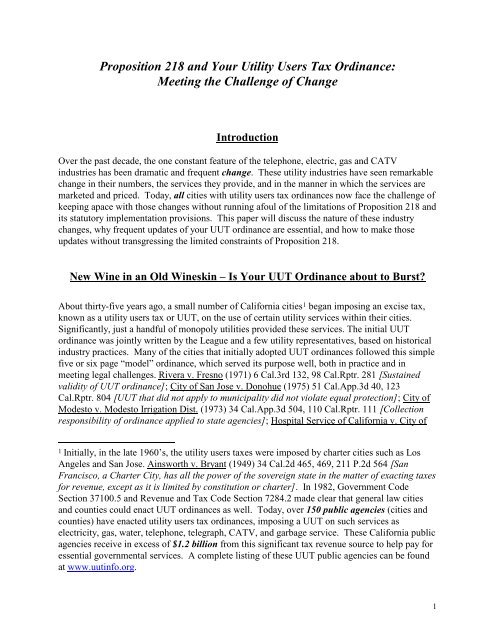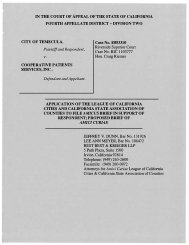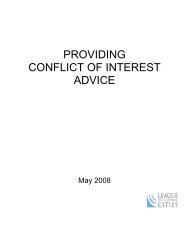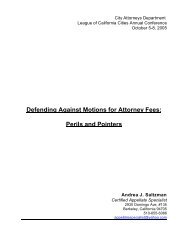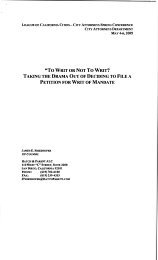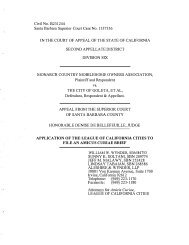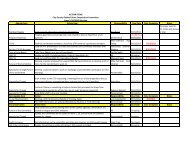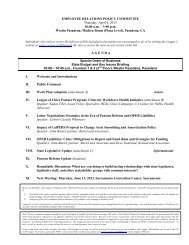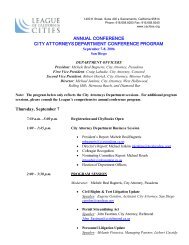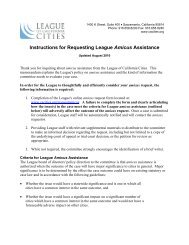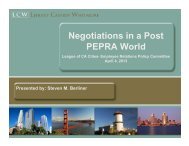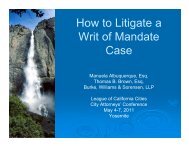Proposition 218 and Your Utility Users Tax Ordinance: - League of ...
Proposition 218 and Your Utility Users Tax Ordinance: - League of ...
Proposition 218 and Your Utility Users Tax Ordinance: - League of ...
Create successful ePaper yourself
Turn your PDF publications into a flip-book with our unique Google optimized e-Paper software.
<strong>Proposition</strong> <strong>218</strong> <strong>and</strong> <strong>Your</strong> <strong>Utility</strong> <strong>Users</strong> <strong>Tax</strong> <strong>Ordinance</strong>:<br />
Meeting the Challenge <strong>of</strong> Change<br />
Introduction<br />
Over the past decade, the one constant feature <strong>of</strong> the telephone, electric, gas <strong>and</strong> CATV<br />
industries has been dramatic <strong>and</strong> frequent change. These utility industries have seen remarkable<br />
change in their numbers, the services they provide, <strong>and</strong> in the manner in which the services are<br />
marketed <strong>and</strong> priced. Today, all cities with utility users tax ordinances now face the challenge <strong>of</strong><br />
keeping apace with those changes without running afoul <strong>of</strong> the limitations <strong>of</strong> <strong>Proposition</strong> <strong>218</strong> <strong>and</strong><br />
its statutory implementation provisions. This paper will discuss the nature <strong>of</strong> these industry<br />
changes, why frequent updates <strong>of</strong> your UUT ordinance are essential, <strong>and</strong> how to make those<br />
updates without transgressing the limited constraints <strong>of</strong> <strong>Proposition</strong> <strong>218</strong>.<br />
New Wine in an Old Wineskin – Is <strong>Your</strong> UUT <strong>Ordinance</strong> about to Burst<br />
About thirty-five years ago, a small number <strong>of</strong> California cities 1 began imposing an excise tax,<br />
known as a utility users tax or UUT, on the use <strong>of</strong> certain utility services within their cities.<br />
Significantly, just a h<strong>and</strong>ful <strong>of</strong> monopoly utilities provided these services. The initial UUT<br />
ordinance was jointly written by the <strong>League</strong> <strong>and</strong> a few utility representatives, based on historical<br />
industry practices. Many <strong>of</strong> the cities that initially adopted UUT ordinances followed this simple<br />
five or six page “model” ordinance, which served its purpose well, both in practice <strong>and</strong> in<br />
meeting legal challenges. Rivera v. Fresno (1971) 6 Cal.3rd 132, 98 Cal.Rptr. 281 [Sustained<br />
validity <strong>of</strong> UUT ordinance]; City <strong>of</strong> San Jose v. Donohue (1975) 51 Cal.App.3d 40, 123<br />
Cal.Rptr. 804 [UUT that did not apply to municipality did not violate equal protection]; City <strong>of</strong><br />
Modesto v. Modesto Irrigation Dist. (1973) 34 Cal.App.3d 504, 110 Cal.Rptr. 111 [Collection<br />
responsibility <strong>of</strong> ordinance applied to state agencies]; Hospital Service <strong>of</strong> California v. City <strong>of</strong><br />
1 Initially, in the late 1960’s, the utility users taxes were imposed by charter cities such as Los<br />
Angeles <strong>and</strong> San Jose. Ainsworth v. Bryant (1949) 34 Cal.2d 465, 469, 211 P.2d 564 [San<br />
Francisco, a Charter City, has all the power <strong>of</strong> the sovereign state in the matter <strong>of</strong> exacting taxes<br />
for revenue, except as it is limited by constitution or charter]. In 1982, Government Code<br />
Section 37100.5 <strong>and</strong> Revenue <strong>and</strong> <strong>Tax</strong> Code Section 7284.2 made clear that general law cities<br />
<strong>and</strong> counties could enact UUT ordinances as well. Today, over 150 public agencies (cities <strong>and</strong><br />
counties) have enacted utility users tax ordinances, imposing a UUT on such services as<br />
electricity, gas, water, telephone, telegraph, CATV, <strong>and</strong> garbage service. These California public<br />
agencies receive in excess <strong>of</strong> $1.2 billion from this significant tax revenue source to help pay for<br />
essential governmental services. A complete listing <strong>of</strong> these UUT public agencies can be found<br />
at www.uutinfo.org.<br />
1
Oakl<strong>and</strong> (1972) 25 Cal.App.3d 402, 101 Cal.Rptr. 800 [Nonpr<strong>of</strong>it corporations not exempt from<br />
UUT by state statute]; Fenton v. City <strong>of</strong> Delano (1984) 162 Cal.App.3d 400, 208 Cal.Rptr. 486;<br />
Campen v. Greiner (1971) 15 Cal.App.3d 836, 93 Cal.Rptr. 525 [UUT not subject to<br />
referendum].<br />
However, in the 1980s, major changes were on the horizon, with the essential character <strong>of</strong> the<br />
monopoly utility provider beginning to unravel. These events also forebode the possibility <strong>of</strong><br />
future problems for the cities’ UUT ordinances, <strong>and</strong> their ability to reflect such major changes<br />
without some amendatory language.<br />
The Times, They Are A’Chang’n<br />
In the 1980's, the monolithic gas <strong>and</strong> telephone industries experienced dramatic institutional<br />
changes. First, the state <strong>and</strong> federal regulatory commissions began employing competition <strong>and</strong><br />
market pricing as alternatives to micro-managing the regulated monopoly utilities. The Federal<br />
Energy Regulatory Commission broke open the interstate pipeline/gas supply market, <strong>and</strong> soon<br />
thereafter, the California Public Utilities Commission introduced competition in the sale <strong>of</strong><br />
natural gas to retail customers. Many new third party marketers, such as ENRON <strong>and</strong><br />
Broadstreet, could now compete with the regulated monopoly providers (PG&E, SoCalGas <strong>and</strong><br />
SDG&E) in the retail sale <strong>of</strong> the commodity <strong>of</strong> natural gas. The result was more utility providers,<br />
more competition, <strong>and</strong>, more complicated gas bills, resulting in more opportunity for noncompliance<br />
in the collection <strong>of</strong> the UUT.<br />
Second, the scope <strong>of</strong> the UUT also began to exp<strong>and</strong>. A U.S. Supreme Court decision [Goldberg<br />
v. Sweet (1989) 488 U.S. 2520] removed a previously-thought constitutional impediment to<br />
imposing the UUT on interstate <strong>and</strong> international telephone service (instead <strong>of</strong> just intrastate).<br />
In response, many cities amended their ordinances <strong>and</strong> began imposing a UUT on interstate <strong>and</strong><br />
international telephone services. This produced increased tax revenues for those cities, but it also<br />
exp<strong>and</strong>ed the number <strong>of</strong> tax collectors <strong>of</strong> their UUT on telecommunications from one or two to<br />
several (e.g., SPRINT, MCI appeared following the court-imposed breakup <strong>of</strong> Ma Bell].<br />
The changes in the 1980s were soon followed by even more dramatic changes in the 1990's. The<br />
California Public Utilities Commission (CPUC) essentially deregulated the long distance<br />
telephone industry, resulting in hundreds on new long distance resellers. Also, a br<strong>and</strong> new<br />
telecommunication industry, called “cellular” or “wireless”, prominently appeared on the scene<br />
in the early 1990s. Today, there are over six hundred wired <strong>and</strong> wireless telecommunication<br />
providers licensed by the CPUC, providing telecommunication services by wires, radio waves<br />
(using various b<strong>and</strong>s <strong>of</strong> the radio spectrum), fiber optics, satellite, <strong>and</strong> microwave. Through<br />
mergers, acquisitions, <strong>and</strong> name changes, the identity <strong>of</strong> these companies present enormous tax<br />
enforcement problems for the UUT tax administrators <strong>and</strong> tax auditors <strong>of</strong> the cities.<br />
In the late 1990’s, based on the success <strong>of</strong> its telecommunications <strong>and</strong> gas deregulation efforts,<br />
the CPUC next directed its deregulation initiative to the electric industry. In 2000, the state<br />
legislature enacted implementation legislation to formalize the electric deregulation process.<br />
Like the gas industry, the main area <strong>of</strong> new competition was in the sale <strong>of</strong> the commodity <strong>of</strong><br />
2
electricity, <strong>and</strong> 150 new electric service providers (ESPs) suddenly appeared with little or no<br />
underst<strong>and</strong>ing <strong>of</strong> their obligation to collect local taxes.<br />
Although California’s experience in the deregulation <strong>of</strong> the electric commodity market has<br />
largely failed due to record high “commodity” prices in 2001, the break-up <strong>of</strong> the traditional<br />
monopoly electric provider continues 2 . The result is more <strong>and</strong> more electric “companies”<br />
providing diverse, “unbundled” services, with more opportunities to improperly collect the<br />
UUT.<br />
Taken together, the above described developments <strong>of</strong> the past thirty years have greatly<br />
complicated the collection <strong>of</strong> the cities’ UUT, with many new utility providers <strong>of</strong>fering new or<br />
differentiated services. To further exacerbate the problem, many California cities have neglected<br />
to update their UUT ordinances to keep pace with these dramatic changes. This oversight is<br />
likely due to the complicated <strong>and</strong> arcane nature <strong>of</strong> utilities <strong>and</strong> their regulation, <strong>and</strong> also the fear<br />
<strong>of</strong> triggering an election requirement under <strong>Proposition</strong> <strong>218</strong>. These reasons for inaction are<br />
certainly underst<strong>and</strong>able, but not without the following risks:<br />
• First, UUT ordinance language that fails to reflect new technologies for<br />
delivering traditional utility services may result in ambiguity that produces<br />
loopholes <strong>and</strong> unintended tax subsidies for those new technologies <strong>and</strong> services,<br />
at the expense <strong>of</strong> citizens that can least afford the new technologies <strong>and</strong> services.<br />
Importantly, ambiguities in tax ordinances are strictly construed in favor <strong>of</strong> the<br />
taxpayer, <strong>and</strong> against the public agency. 3<br />
• Second, through such neglect, UUT ordinances may become legally invalid, in<br />
part or in whole, when similar utility services (though delivered through different<br />
means, e.g., wired versus wireless telecommunication services) are treated<br />
differently without a rationale 4 for such different treatment.<br />
2 The CPUC required PG&E <strong>and</strong> Edison to “divest” <strong>of</strong> many <strong>of</strong> their power generation resources.<br />
PG&E, through the bankruptcy process, has recently created new legal entities for providing its<br />
transmission <strong>and</strong> distribution services, which were previously provided by a single integrated<br />
utility.<br />
3 Los Angeles Brewing Co. v. City <strong>of</strong> Los Angeles (1935) 8 Cal.App.2d 379, 48 P.2d 65.<br />
4 Public agencies must be able to establish some rationale for taxing similar services differently.<br />
[Louisville Gas Co. v. Coleman (1928) 277 U. S. 32: while the state may classify broadly the<br />
subjects <strong>of</strong> taxation, it must do so on a rational basis so that all persons similarly circumstanced<br />
shall be treated alike].<br />
Once a rationale is established, however, cities have a great deal <strong>of</strong> latitude as evidenced by the<br />
following case law: City <strong>of</strong> San Jose v. Donohue (1975) 51 Cal.App.3d 41; Willingham Bus<br />
Lines, Inc. v. Municipal Court (1967) 59 Cal.Rptr. 618, 428 P.2d 602 [Absolute uniformity or<br />
equality in the application <strong>of</strong> tax measures can never be obtained]. Ladd v. State Bd. <strong>of</strong><br />
Equalization (1973) 106 Cal.Rptr. 885 [A tax statute or ordinance which distinguishes between<br />
parties does not violate the equal protection or due process clause if the distinction rests upon a<br />
3
• Third, ambiguously worded UUT ordinances will invite legal challenges<br />
regarding the scope 5 <strong>of</strong> a UUT or the collection responsibilities 6 <strong>of</strong> the collecting<br />
party, resulting in possibly avoidable litigation. In the case <strong>of</strong> an adverse judicial<br />
decision, it may even result in a refund obligation <strong>and</strong> a permanent reduction in<br />
UUT revenues.<br />
If It’s Broke, Better Fix It!<br />
How can these legal controversies best be avoided Clearly, ambiguities in ordinance language<br />
that define the “scope” <strong>of</strong> each UUT must be carefully removed <strong>and</strong> substituted with appropriate<br />
clarifying language that does not exp<strong>and</strong> the tax, but rather clarifies it.<br />
However, as previously mentioned, many cities are reluctant to make any change to their UUT<br />
ordinances out <strong>of</strong> fear <strong>of</strong> triggering the election requirement <strong>of</strong> <strong>Proposition</strong> <strong>218</strong>. But is<br />
<strong>Proposition</strong> <strong>218</strong> that all-encompassing No, it is not. Only those ordinance changes that<br />
increase the UUT rate or “revise the methodology” (e.g., expansion <strong>of</strong> the tax base) are subject to<br />
an electoral approval under <strong>Proposition</strong> <strong>218</strong>. Government Code Section 53750 et seq. Although<br />
there are no appellate court decisions explaining the meaning <strong>of</strong> a “revision in methodology”,<br />
<strong>and</strong> opinions may differ as to when a “clarification” becomes a “revised methodology”, the<br />
touchstone will inevitably be, does a tax increase result. Therefore, it is reasonable to assume<br />
that a city may update its UUT ordinance, without triggering a <strong>Proposition</strong> <strong>218</strong> election, by<br />
enacting: i) clarifications regarding the scope <strong>of</strong> its existing tax base (especially where the<br />
clarification does not increase the tax but merely clarifies historical practices) 7 ; ii) clarifications<br />
regarding the tax collection obligations <strong>of</strong> utility providers <strong>and</strong> utility customers regarding an<br />
existing tax; <strong>and</strong>, iii) amendments that provide procedural <strong>and</strong> administrative improvements to<br />
the thirty year old UUT ordinance. This paper will <strong>of</strong>fer examples <strong>of</strong> updates in each <strong>of</strong> those<br />
areas.<br />
rational basis, <strong>and</strong> it must be presumed to rest on that basis if there is any conceivable state <strong>of</strong><br />
facts which would support it.] Stevens v. Watson (1971) 94 Cal.Rptr. 190 [A legislature is not<br />
bound to tax every member <strong>of</strong> a particular class or none]. Henry's Restaurants <strong>of</strong> Pomona, Inc. v.<br />
State Bd. <strong>of</strong> Equalization (1973) 106 Cal.Rptr. 867 [It is constitutionally permissible to subdivide<br />
the class on the basis <strong>of</strong> the tax collectibility problem]. Carmichael v. Southern Coal Co. (1937)<br />
301 U.S. 495, 511 [Administrative convenience <strong>and</strong> expense in the collection or measurement <strong>of</strong><br />
a tax are alone a sufficient justification for treating some taxpayers differently than others].<br />
5 Balikov v. Southern California Gas Co. (2001) 94 Cal.App.4 th 816 [<strong>Tax</strong>payer challenged<br />
applicability <strong>of</strong> UUT to “regulatory surcharges” on gas bills]..<br />
6 Eastern Mun. Water Dist. V. City <strong>of</strong> Moreno Valley (1995) 31 Cal.App.4 th 24, 36 Cal. Rptr.2d<br />
823; City <strong>of</strong> Modesto v. Modesto Irrigation Dist. (1973) 34 Cal.App.3d 504, 110 Cal.Rptr. 111.<br />
7 A city may also make clarifications to the “scope” <strong>of</strong> a tax through the adoption <strong>of</strong><br />
administrative rulings. See pp. 6-7 below.<br />
4
Clarity to Avoid Unnecessary Legal Risks<br />
The following are three suggestions for removing ambiguity <strong>and</strong> achieving ordinance clarity,<br />
without triggering a <strong>Proposition</strong> <strong>218</strong> election:<br />
Broad Functional Description <strong>of</strong> the <strong>Utility</strong> Service with Examples. In my view, much<br />
controversy with taxpayers <strong>and</strong> their tax (avoidance) counselors over ordinance language can be<br />
averted if the UUT ordinance is amended with language that provides a “functional” description<br />
<strong>of</strong> the utility service, using broad language that will capture future changes in technology for<br />
delivering the services. For example, in the area <strong>of</strong> telecommunications, it would be prudent to<br />
define “telecommunication service” to include any use <strong>of</strong> the “public switched network 8<br />
regardless <strong>of</strong> the technology used to deliver the service”.<br />
In addition to using a generally worded functional definition <strong>of</strong> the taxable utility service,<br />
ambiguity can be further avoided by including a list <strong>of</strong> examples that fall within the functional<br />
definition. The list <strong>of</strong> examples should be preceded by the key words “including but not limited<br />
to”. The Cities <strong>of</strong> San Gabriel, San Le<strong>and</strong>ro, <strong>and</strong> La Verne have recently adopted updated UUT<br />
ordinance language that employs this technique.<br />
TELEPHONE COMMUNICATION SERVICES. “Communications services” as defined in Sections<br />
4251 <strong>and</strong> 4252 <strong>of</strong> the Internal Revenue Code, <strong>and</strong> the regulations thereunder, <strong>and</strong> shall include<br />
any telephonic quality communication for the purpose <strong>of</strong> transmitting messages or information<br />
[including but not limited to voice (both analog <strong>and</strong> digital – including the use <strong>of</strong> Internet<br />
Protocol (IP) or other similar means for digitization <strong>and</strong>/or packetization <strong>of</strong> telephonic quality<br />
communications for transmission via digital networks, in part or in whole), telegraph,<br />
teletypewriter, data, facsimile, video, or text] by electronic, radio or similar means through<br />
“interconnected service” with the “public switched network” [as these terms are commonly used in<br />
the Federal Communications Act <strong>and</strong> the regulations <strong>of</strong> the Federal Communications Commission<br />
- see 47 U.S.C.A. Section 332(d)], whether such transmission occurs by wire, cable, cable<br />
modem or digital subscriber line (DSL), internet, fiber-optic, light wave, laser, microwave, radio<br />
wave [including, but not limited to, mobile telecommunications service, cellular service,<br />
commercial mobile service <strong>and</strong> commercial mobile radio service (see 47 U.S.C. Section 332(d)(1)<br />
<strong>and</strong> Part 20.3 <strong>of</strong> Title 47 <strong>of</strong> the Code <strong>of</strong> Federal Regulations), personal communications service<br />
(PCS), specialized mobile radio (SMR), <strong>and</strong> other similar services regardless <strong>of</strong> radio spectrum<br />
used], switching facilities, satellite or any other similar facilities (emphasis added).<br />
“Unbundle” <strong>Your</strong> <strong>Ordinance</strong> Language. In addition to using broad, functional definitions <strong>of</strong><br />
the “utility service” with examples, it is also helpful to describe the components <strong>of</strong> such service,<br />
again citing a list <strong>of</strong> components with the key words: “including but not limited to”. Why is this<br />
“unbundling” language necessary In years past, a utility customer would receive a single utility<br />
bill with a single charge for the utility service based upon a rate tariff approved by the California<br />
Public Utilities Commission. Then, various taxes, including the UUT, would be applied to the<br />
utility charge. With deregulation <strong>and</strong> the break-up <strong>of</strong> the monopoly utility companies, however,<br />
the trend is to “unbundle” the single charge into numerous “line items” costing out the various<br />
8 The public switched network or PSN generally refers to the interconnected networks <strong>of</strong> the<br />
telephone companies that allow individuals to make voice quality calls to other individuals with<br />
telephone sets connected to those networks.<br />
5
components <strong>of</strong> the previously bundled utility service so that the customers receives more pricing<br />
information. Supposedly, all <strong>of</strong> this “pricing” information is essential to the customer to make<br />
informed choices, as more <strong>and</strong> more <strong>of</strong> the different components <strong>of</strong> traditional utility service are<br />
opened up to competition. In addition, a customer may receive multiple bills as the utility service<br />
is now provided by different types <strong>of</strong> utility service providers.<br />
Here is the problem: since the old UUT ordinance typically imposes a tax on the “bundled”<br />
charge for the use <strong>of</strong> gas or electricity, arguments can arise when the various components <strong>of</strong> gas<br />
or electric service (e.g., commodity, transmission, storage, metering, etc.) are separately stated or<br />
arrive on multiple bills. A taxpayer might argue that, under the language <strong>of</strong> old ordinance, the<br />
UUT only applies to the commodity charge (“use <strong>of</strong> electricity or gas”) <strong>and</strong> none <strong>of</strong> the other<br />
charges necessary to deliver the commodity to the customer (e.g., charges for transmission <strong>and</strong><br />
gas storage). Some “creative” customers (or more likely their tax avoidance counselors) have, in<br />
fact, already raised this argument. In a case involving the City <strong>of</strong> Torrance <strong>and</strong> a gas customer, a<br />
Superior Court summarily dismissed the taxpayer’s argument that the UUT ordinance did not<br />
apply to “transmission” charges <strong>and</strong> found in favor <strong>of</strong> the City, but not after lengthy, expensive<br />
litigation. Again, the UUT ordinances <strong>of</strong> the cities <strong>of</strong> San Gabriel, LaVerne, <strong>and</strong> San Le<strong>and</strong>ro<br />
are good examples <strong>of</strong> identifying the specific components <strong>of</strong> utility services, including a catch-all<br />
phrase:<br />
“<strong>and</strong> other charges, fee <strong>and</strong> surcharges which are necessary to or common for the receipt, use or<br />
enjoyment <strong>of</strong> electric service; <strong>and</strong> all other annual <strong>and</strong> monthly charges, fees, or surcharges for<br />
electricity services or programs, which are m<strong>and</strong>ated by the California Public Utilities Commission<br />
or the Federal Energy Regulatory Commission, whether or not such charges, fees, or surcharges<br />
appear on a bundled or line item basis on the customer billing.”<br />
To show your intent to comply with the constraints <strong>of</strong> <strong>Proposition</strong> <strong>218</strong>, it would not hurt to<br />
include a “whereas” clause in your amending ordinance that states:<br />
WHEREAS, while modifying the utility users tax ordinance <strong>of</strong> the City <strong>of</strong> in the manner provided<br />
herein, it is not the intent <strong>of</strong> the City Council either to increase the tax percentage imposed on charges<br />
for utility use, or to exp<strong>and</strong> the base <strong>of</strong> the tax.<br />
Administrative Ruling: Another Tool for Addressing Change. As an alternative to frequent<br />
updates to your UUT ordinance to address new, unanticipated changes, another effective tool is<br />
the use <strong>of</strong> the administrative ruling. Merely place a provision in the UUT ordinance that<br />
authorizes the “tax administrator” (as defined by statute) to periodically issue “administrative<br />
rulings” to address questions <strong>of</strong> tax applicability <strong>of</strong> new utility services <strong>and</strong> charges. Of course,<br />
the provision needs to establish some st<strong>and</strong>ards that the “tax administrator” must adhere to.<br />
Also, it would be wise to include an “administrative” procedure that the taxpayer must follow to<br />
appeal the ruling.<br />
AUTHORIZING PROVISION. The <strong>Tax</strong> Administrator may adopt administrative rules <strong>and</strong> regulations<br />
not inconsistent with provisions <strong>of</strong> this chapter for the purpose <strong>of</strong> carrying out <strong>and</strong> enforcing the<br />
payment, collection <strong>and</strong> remittance <strong>of</strong> the taxes herein imposed. A copy <strong>of</strong> such administrative rules<br />
<strong>and</strong> regulations shall be on file in the <strong>Tax</strong> Administrator’s <strong>of</strong>fice.<br />
6
EXERCISE OF AUTHORITY. The <strong>Tax</strong> Administrator, from time to time, may survey the electric<br />
Service Suppliers to identify the various unbundled billing components <strong>of</strong> electric retail service that<br />
they commonly provide to residential <strong>and</strong> commercial/industrial customers in the City, <strong>and</strong> the charges<br />
therefor, including those items that are m<strong>and</strong>ated by State or federal regulatory agencies as a<br />
condition <strong>of</strong> providing such electric service. The <strong>Tax</strong> Administrator, thereafter, may issue <strong>and</strong><br />
disseminate to such electric Service Suppliers an administrative ruling identifying those components<br />
<strong>and</strong> items which are: i) necessary for or common to the receipt, use or enjoyment <strong>of</strong> electric service;<br />
or, ii) currently, or historically have been, included in a single or bundled rate for electric service by a<br />
local distribution company to a class <strong>of</strong> retail customers. Charges for such components <strong>and</strong> items<br />
shall be subject to the tax <strong>of</strong> subsection (A) above.<br />
Such provisions would require the challenging tax payer to focus on the “ruling” under an<br />
administrative procedure, rather than filing a lawsuit challenging the specific wording <strong>of</strong> your<br />
UUT ordinance. If the challenging party fails to exhaust his or her administrative remedy, then<br />
no legal challenge could be made. In the event that a court determined that an administrative<br />
ruling exceeded the “scope” <strong>of</strong> the ordinance, the city tax administrator would merely rescind the<br />
ruling, <strong>and</strong> the UUT ordinance would remain unscathed.<br />
“Bundle” <strong>Your</strong> <strong>Ordinance</strong> Too. As the gas <strong>and</strong> electric industries began “unbundling” their<br />
previously integrated services, the wireless telephone <strong>and</strong> CATV industries found that it was<br />
more effective to market their service by “bundling” a variety <strong>of</strong> different services into<br />
“packages” designed to attract certain customer classes. Often times, both taxable <strong>and</strong> nontaxable<br />
services would be included in the “bundled”, single-priced packages. How are these<br />
“packages” to be taxed According to a federal excise tax statute [26 USC §4254(a)] 9 , if the<br />
various services are grouped together, <strong>and</strong> are not separately stated on the bill, then the entire<br />
“package” is taxed. There is also a dubious IRS Ruling 69-152 (which the IRS contends is its<br />
current position) that permits the telecom provider to internally “unbundle” the taxable <strong>and</strong> nontaxable<br />
services, <strong>and</strong> then apply the tax to the imputed value <strong>of</strong> only the taxable services using<br />
normal accounting practices. This ruling appears to contradict the statutory language <strong>of</strong> 26 USC<br />
§4254(a).<br />
In any event, it may be prudent to amend the UUT ordinance to specifically deal with the<br />
“bundling” <strong>of</strong> taxable <strong>and</strong> non-taxable services. Here is one approach.<br />
35.086 EFFECT OF COMMINGLING NON-TAXABLE ITEMS WITH TAXABLE ITEMS.<br />
If one or more non-taxable items are bundled or billed together with one or more taxable items (as<br />
provided for by this subchapter) under a single charge on a customer’s bill, the entire single<br />
charge shall be deemed taxable unless, upon the written request <strong>of</strong> the customer, the service<br />
supplier can reasonably identify the non-taxable component <strong>of</strong> the single charge based upon one<br />
or more <strong>of</strong> the following methodologies, as selected by the <strong>Tax</strong> Administrator: i) the average<br />
9 Sec. 4254. Computation <strong>of</strong> tax. (a) GENERAL RULE – If a bill is rendered the taxpayer for local<br />
telephone service or toll telephone service -(1) the amount on which the tax with respect to such services<br />
shall be based shall be the sum <strong>of</strong> all charges for such services included in the bill; except that (2) if the<br />
person who renders the bill groups individual items for purposes <strong>of</strong> rendering the bill <strong>and</strong> computing the<br />
tax, then (A) the amount on which the tax with respect to each such group shall be based shall be the sum<br />
<strong>of</strong> all items within that group, <strong>and</strong> (B) the tax on the remaining items not included in any such group shall<br />
be based on the charge for each item separately.<br />
7
industry charges for the individual non-taxable items included in the entire single charge; ii) the<br />
amount <strong>of</strong> the entire single charge less the average industry charges for the individual taxable<br />
items included in the entire single charge; or, iii) the service supplier’s books <strong>and</strong> records that are<br />
kept in the regular course <strong>of</strong> business, which must be consistent with generally accepted<br />
accounting principles.<br />
Substantial Nexus for Imposition <strong>of</strong> Telecom UUT<br />
Two Out <strong>of</strong> Three Rule – Goldberg v. Sweet. In order for a tax to be legally imposed, “nexus”<br />
must exist. “Nexus” simply means there is sufficient “contacts” or activities between the<br />
taxpayer or tax collecting party <strong>and</strong> the city to justify the imposition <strong>of</strong> the tax obligation. With<br />
respect to the UUT, there is clearly adequate nexus for imposing the tax, since the UUT is based<br />
upon the use <strong>of</strong> the utility service by a person in the city. Thus, the physical presence (<strong>of</strong>ten a<br />
common trait <strong>of</strong> nexus) <strong>of</strong> the customer normally exists.<br />
But what about the case <strong>of</strong> wireless telecommunications where the taxpayer is “mobile” <strong>and</strong> the<br />
call’s origination or termination is difficult if not impossible to determine by the tax collecting<br />
wireless company 10 Is there sufficient nexus to impose a UUT on charges for wireless calls<br />
The answer is not without considerable controversy <strong>and</strong> complexity.<br />
In the early 1990’s when cellular telecommunication services began using the “public switched<br />
network”, this burgeoning industry contended that public agencies could only impose a UUT on<br />
the non-call portion <strong>of</strong> the cellular bill (originally, a “monthly access fee” that must be paid<br />
whether or not any calls were made). The cellular industry representatives cited the case <strong>of</strong><br />
[Goldberg v. Sweet (1989) 488 U.S. 252] in support <strong>of</strong> the “two out <strong>of</strong> three” rule as the<br />
applicable law, i.e,. to apply an excise tax on interstate telecommunications 11 , the call must either<br />
originate or terminate within the taxing jurisdiction <strong>and</strong> the billing address must also be in the<br />
taxing jurisdiction. Interestingly, Goldberg did not directly address the nexus issue, but rather, as<br />
dicta, acknowledged that the “two out <strong>of</strong> three” rule <strong>of</strong> the Illinois state statute was not<br />
challenged by any <strong>of</strong> the parties as lacking substantial nexus. Subsequent cases, however, have<br />
cited Goldberg as a “nexus” case. Oklahoma <strong>Tax</strong> Commission v. Jefferson Lines (1995) 115<br />
U.S. 1331.<br />
10 In the near future, h<strong>and</strong>held phones will include the capability <strong>of</strong> interacting with satellites or<br />
other geo-locational systems to identify the locations <strong>of</strong> 911 emergency calls within a few<br />
hundred yards. FCC Docket CC No. 94-102 (See: www.fcc.gov/911/enhanced).<br />
11 Prior to Goldberg, public agencies did not apply a UUT on interstate <strong>and</strong> international<br />
telecommunication calls believing that such a tax was prohibited by federal law (Commerce<br />
Clause). When Goldberg clarified how a public agency might properly apply an excise tax to<br />
interstate <strong>and</strong> international calls, many California UUT ordinances were amended to include<br />
interstate <strong>and</strong> international calls. A number <strong>of</strong> public agencies failed to make this change, <strong>and</strong><br />
now can only do so with a <strong>Proposition</strong> <strong>218</strong> election.<br />
8
It was not long after the wireless industry began <strong>of</strong>fering services that it stopped using a<br />
“monthly access” fee, <strong>and</strong> began marketing its services primarily as “packages” with pricing<br />
based on the number <strong>of</strong> included “free minutes”. Importantly, the fixed monthly charge for the<br />
package must be paid by the customer regardless whether any <strong>of</strong> the included minutes were used.<br />
As a temporary accommodation, some cities allowed the early cellular companies to use an<br />
imputed value as a surrogate for the former “monthly access” charge. AT&T Wireless <strong>and</strong><br />
Verizon Wireless persist in following that dubious practice today.<br />
Agreement, Payment <strong>and</strong> Delivery – Jefferson Lines. Today, there are new reasons to<br />
contend that wireless companies should be applying the UUT on the entire “package”, in the<br />
same manner as the federal excise tax is applied to wired <strong>and</strong> wireless telecommunications. In<br />
1995, the U.S. Supreme Court decided Oklahoma <strong>Tax</strong> Commission v. Jefferson Lines (1995) 115<br />
U.S. 1331. The Court held that the state <strong>of</strong> Oklahoma could impose a tax on a bus ticket<br />
purchased in Oklahoma, even though some <strong>of</strong> the services would be provided out <strong>of</strong> the taxing<br />
jurisdiction. Here are some pertinent excerpts from the Jefferson Lines case:<br />
So, too, in addressing the interstate provision <strong>of</strong> services, we recently held that a State in which<br />
an interstate telephone call originates or terminates has the requisite Commerce Clause nexus to<br />
tax a customer's purchase <strong>of</strong> that call as long as the call is billed or charged to a service address,<br />
or paid by an addressee, within the taxing State. Goldberg, supra, at 263. Oklahoma's tax falls<br />
comfortably within these rules. Oklahoma is where the ticket is purchased, <strong>and</strong> the service<br />
originates there. These facts are enough for concluding that "[t]here is `nexus' aplenty here."<br />
Interstate activity may be essential to a substantial portion <strong>of</strong> the value <strong>of</strong> the services in the first<br />
case <strong>and</strong> essential to performance <strong>of</strong> the services in the second, but sales with at least partial<br />
performance in the taxing State justify that State's taxation <strong>of</strong> the transaction's entire gross<br />
receipts in the h<strong>and</strong>s <strong>of</strong> the seller.<br />
In the context <strong>of</strong> taxation <strong>of</strong> wireless “packages”, a strong argument can be made that a public<br />
agency should have sufficient nexus under the Jefferson Lines case to impose the UUT on the<br />
entire wireless “package” since the “package” is purchased <strong>and</strong> paid within the public agency <strong>and</strong><br />
some <strong>of</strong> the services (calls) occur there.<br />
The taxable event comprises agreement, payment, <strong>and</strong> delivery <strong>of</strong> some <strong>of</strong> the services in the<br />
taxing State; no other State can claim to be the site <strong>of</strong> the same combination. The economic<br />
activity represented by the receipt <strong>of</strong> the ticket for "consumption" in the form <strong>of</strong> commencement<br />
<strong>and</strong> partial provision <strong>of</strong> the transportation thus closely resembles Berwind-White's "delivery <strong>of</strong><br />
goods within the State upon their purchase for consumption," id., at 58, especially given that full<br />
"consumption" or "use" <strong>of</strong> the purchased goods within the taxing State has never been a condition<br />
for taxing a sale <strong>of</strong> those goods. Oklahoma <strong>Tax</strong> Commission v. Jefferson Lines.<br />
One ordinance feature that is important to satisfy federal Commerce Clause concerns under<br />
Goldberg <strong>and</strong> Jefferson Lines is a crediting provision to avoid taxation <strong>of</strong> the same transaction by<br />
multiple taxing jurisdictions. Although this is merely a theoretical problem, <strong>and</strong> does not occur<br />
in practice, it is wise to include the following provision in your UUT ordinance:<br />
To prevent actual multi-jurisdictional taxation <strong>of</strong> telephone communication services subject to tax<br />
under this section, any service user, upon pro<strong>of</strong> to the <strong>Tax</strong> Administrator that the service user has<br />
previously paid the same tax in another state or city on such telephone communication services,<br />
shall be allowed a credit against the tax imposed to the extent <strong>of</strong> the amount <strong>of</strong> such tax legally<br />
9
imposed in such other state or city; provided, however, the amount <strong>of</strong> credit shall not exceed the<br />
tax owed to the city under this section.<br />
Primary Place <strong>of</strong> Use – Federal Wireless Telecommunications Sourcing Act <strong>of</strong> 2000. Given<br />
the mobile nature <strong>of</strong> its service, the wireless industry was plagued with a number <strong>of</strong> tax <strong>and</strong> cost<br />
allocation problems. It decided to get some help through federal legislation, known as the federal<br />
Wireless Telecommunications Sourcing Act <strong>of</strong> 2000. Among other things, the act authorizes the<br />
imposition <strong>of</strong> state <strong>and</strong> local excise taxes on wireless communication charges irrespective <strong>of</strong> the<br />
call’s origination or termination. In other words, for wireless telecommunications, taxable nexus<br />
is based upon the customer’s “primary place <strong>of</strong> use”, <strong>and</strong> not the call’s origination or termination<br />
(as required under the “two out <strong>of</strong> three” rule <strong>of</strong> Goldberg).<br />
In anticipation <strong>of</strong> the effective date <strong>of</strong> this new federal law (August, 2002), a number <strong>of</strong> public<br />
agencies adopted “instructions” directing the wireless providers to collect the UUT consistent<br />
with the “sourcing rules” <strong>of</strong> the federal law. See www.uutinfo.org “Best Practices Policy 1.0”.<br />
Many UUT ordinances, including those enacted prior to January 1, 1995 (<strong>Proposition</strong> <strong>218</strong>), have<br />
specific language that imposes the UUT <strong>of</strong> telecommunication charges, regardless <strong>of</strong> whether the<br />
call originated or terminated within the city. Other city ordinances did not address the issue one<br />
way or the other.<br />
By issuing such “administrative” rulings, the local tax administrators intended to follow the<br />
federal sourcing rules, <strong>and</strong> thus st<strong>and</strong>ardize the tax collection practices <strong>of</strong> the wireless industry 12<br />
To the chagrin <strong>of</strong> these public agencies, however, they received “friendly” letters from AT&T<br />
Wireless in June, 2002, threatening to file lawsuits against them, characterizing such instructions<br />
as “revisions in methodology resulting in an increased tax” requiring an authorizing election<br />
under <strong>Proposition</strong> <strong>218</strong> 13 . After months <strong>of</strong> negotiations between AT&T Wireless/Verizon<br />
Wireless <strong>and</strong> a voluntary public agency group known as the <strong>Utility</strong> <strong>Users</strong> <strong>Tax</strong> Technical Task<br />
Force or UUT TTF, the UUT TTF (upon receiving advice from <strong>League</strong> City Attorneys<br />
Department ad hoc utility tax committee) determined that AT&T Wireless’ argument was<br />
doubtful, at best.<br />
The City Attorneys Department ad hoc utility tax committee concluded that most UUT public<br />
agencies possessed a variety <strong>of</strong> legal arguments to counter the position <strong>of</strong> AT&T Wireless, <strong>and</strong><br />
that individual UUT public agencies should decide, after carefully reviewing their UUT<br />
12 AT&T Wireless <strong>and</strong> Verizon Wireless collect approximately 40% <strong>of</strong> the entire charges, still<br />
using the old “imputed” monthly access charge approach. The other three major companies<br />
(Nextel, SPRINT <strong>and</strong> Cingular) collect at the 100% level, as if the federal souring rules applied.<br />
13 In the view <strong>of</strong> the author <strong>and</strong> many other City Attorneys, AT&T Wireless legal contention is<br />
incorrect. In our view, a “revision in methodology” refers to a revision in the actual language <strong>of</strong><br />
the UUT ordinance as it existed on January 1, 1995, that results in an increased tax. It does not<br />
apply to an administrative or tax enforcement decision by the tax administrator to collect less<br />
than the full amount that is authorized by the UUT ordinance due to practical difficulties in<br />
tracking call origination <strong>and</strong> termination or for other administrative reasons. Ultimately, this<br />
disputed issue may require a judicial ruling to satisfy AT&T Wireless’ attorneys.<br />
10
ordinances <strong>and</strong> administrative histories, whether to: 1) seek judicial guidance on this matter<br />
(through a self-initiated declaratory relief action or in defense <strong>of</strong> litigation brought by wireless<br />
carriers or taxpayers); 2) negotiate an acceptable resolution with the wireless carriers; 3) seek a<br />
legislative cure; 4) take a wait <strong>and</strong> see approach, <strong>and</strong> do nothing; or, 5) seek approval <strong>of</strong> the<br />
electorate <strong>of</strong> clarifying language in the UUT ordinance that specifically follows the “source<br />
rules” <strong>of</strong> the federal law.<br />
If your public agency has a UUT ordinance that applies its UUT to wireless telecommunications,<br />
you may receive additional information on this subject, including legal analyses, by contacting<br />
JoAnne Speers <strong>of</strong> the <strong>League</strong> Legal Department <strong>and</strong> by executing a joint confidentiality<br />
agreement.<br />
Substantial Nexus for <strong>Tax</strong> Collection<br />
Nexus comes into play not only in the imposition <strong>of</strong> the UUT, but also in its collection.<br />
Historically, nexus was not a serious issue with UUT because the monopoly utility service<br />
providers installed their physical facilities within the taxing jurisdictions as a means <strong>of</strong> providing<br />
their services, <strong>and</strong> “physical presence” has always satisfied the nexus requirement 14 . However,<br />
what about the new third party commodity marketers, telecom resellers, <strong>and</strong> Internet telephony<br />
providers, which arguably have no physical presence within the city, <strong>and</strong>, in fact, may be located<br />
out <strong>of</strong> state. Can they be required to collect a city’s UUT That depends on whether you<br />
subscribe to the physical presence versus economic presence or alter ego/agency 15 theories <strong>of</strong><br />
legal nexus. Unfortunately, until the U.S. Supreme Court provides clear direction, we find<br />
ourselves in one <strong>of</strong> those “evolving” areas <strong>of</strong> the law.<br />
To deal with the problem <strong>of</strong> nexus uncertainty, there are several ordinance actions worth<br />
considering. First, the UUT ordinance should be amended to remove any language that arguably<br />
is contrary to the broadest definition <strong>of</strong> substantial nexus for requiring the collection <strong>of</strong> the<br />
public agency’s UUT. For example, the UUT ordinance should be amended to broadly impose<br />
the tax collection responsibility on all utility service providers, whether or not they have a<br />
physical presence in the public agency.<br />
14 Quill Corp. v. North Dakota (1992) 504 U.S. 290, 315; National Bellas Hess, Inc. v.<br />
Department <strong>of</strong> Revenue <strong>of</strong> Illinois (1967) 386 U.S. 753. The Due Process <strong>and</strong> Commerce<br />
Clauses <strong>of</strong> the U.S. Constitution prohibit a state from imposing a use tax collection duty on a<br />
seller whose only connection with customers in the state is by common carrier <strong>of</strong> the mail.<br />
15 Tyler Pipe Industries v. Washington State Department <strong>of</strong> Revenue (1987) 483 U.S. 232;<br />
National Geographic v. California Board <strong>of</strong> Education (1977) 430 U.S. 551; Scripto Inc. v.<br />
Carson (1960) 362 U.S. 207. Robert C. Bricker, Agency <strong>and</strong> Affiliate Nexus For Sales <strong>and</strong> Use<br />
<strong>Tax</strong>, 13 J.St.<strong>Tax</strong>’n 61 (1995); John P. Barrie, Attributional Nexus: <strong>Tax</strong>ing Corporations That<br />
Lack Sufficient In-State Presence, 4 J. Multistate <strong>Tax</strong>’n 18 (1994); R. Scot Grierson, State<br />
<strong>Tax</strong>ation <strong>of</strong> the Information Highway: A Proposal For <strong>Tax</strong>ation <strong>of</strong> Information Services,<br />
Institute <strong>of</strong> Property <strong>Tax</strong>ation: Sales <strong>Tax</strong> Report; July-August, 1996, pp 23-31.<br />
11
Second, in this writer’s opinion, the UUT ordinance should be amended to affirmatively state the<br />
UUT ordinance’s intent to employ the broadest construction nexus allowed by law. Here is an<br />
example <strong>of</strong> such language from the San Gabriel UUT ordinance:<br />
For purposes <strong>of</strong> establishing substantial nexus for the imposition <strong>and</strong> collection <strong>of</strong> utility users tax<br />
on charges for telephone communication services pursuant to this subchapter, “minimum<br />
contacts” shall be construed broadly in favor <strong>of</strong> the imposition <strong>and</strong> collection <strong>of</strong> the utility users tax<br />
to the fullest extent permitted by California <strong>and</strong> federal law, <strong>and</strong> as it may change from time to<br />
time by judicial interpretation or by statutory enactment.<br />
Finally, as a failsafe provision, the UUT ordinance should be amended to specify that the<br />
collection obligation falls to the tax payer (i.e., self-collection <strong>and</strong> remittance) in the event that<br />
insufficient nexus exists to require the utility provider to do so. This type <strong>of</strong> provision has been<br />
an effective tool in collecting the UUT from non-core gas <strong>and</strong> direct access electric customers<br />
when out <strong>of</strong> state marketers refuse to do so. Here is a sample provision:<br />
35.085 SERVICE USERS RECEIVING DIRECT PURCHASE OF GAS OR ELECTRICITY.<br />
(A) Any service user subject to the tax imposed by Sections <strong>of</strong> this subchapter, which produces<br />
gas or electricity for self-use; which receives gas or electricity, including any related supplemental<br />
services, directly from a non-utility service supplier not under the jurisdiction <strong>of</strong> this<br />
subchapter; or which, for any other reason, is not having the full tax collected <strong>and</strong> remitted by its<br />
service supplier, a non-utility service supplier, or its billing agent on the use <strong>of</strong> gas or electricity in<br />
the city, including any related supplemental services, shall report said fact to the <strong>Tax</strong><br />
Administrator <strong>and</strong> shall remit the tax due directly to the <strong>Tax</strong> Administrator within thirty (30) days <strong>of</strong><br />
such use (emphasis added).<br />
With respect to amending your UUT ordinance to clarify <strong>and</strong> arguably broaden the tax collection<br />
responsibility (as opposed to tax imposition), keep in mind that such a change does not exp<strong>and</strong> or<br />
increase the tax burden on the taxpayer, since the tax already applies to such usage. Therefore,<br />
such an amendment, clarifying the collection responsibility <strong>of</strong> the tax collector, should not<br />
require a <strong>Proposition</strong> <strong>218</strong> approval by the electorate.<br />
Reduce Legal Risks <strong>and</strong> Refund Exposure with Protective Provisions<br />
Even if your city makes all <strong>of</strong> the recommended “updates” to its UUT ordinance discussed<br />
above, there is no guarantee that a future court might not find that the city’s good faith<br />
application <strong>of</strong> its UUT to a new utility technology or service has exceeded the permissible scope<br />
<strong>of</strong> the UUT ordinance (as it existed on January 1, 1995). What can a city attorney do to reduce<br />
the risk <strong>of</strong> litigation <strong>and</strong> the risk <strong>of</strong> associated refunds<br />
Class Action Lawsuits. A city attorney can greatly reduce the threat <strong>of</strong> class action lawsuits<br />
challenging the validity <strong>of</strong> the City by clearly stating the requirement that no lawsuit may be filed<br />
unless an individual refund claim is first filed. Woosley v. State <strong>of</strong> California (1992) 3 Cal.4th<br />
758, 13 Cal.Rptr.2d 30; American President Lines, Ltd. V. Zolin (1995) 38 Cal.App.4th 910<br />
[Must pay tax <strong>and</strong> follow state or local refund procedures before bringing suit]; Hartman v. City<br />
12
<strong>of</strong> Hawthorne, unpublished decision (2001), B136680. 2nd Appellate District. [No declaratory<br />
relief in Prop. <strong>218</strong> challenge. Must first pay tax <strong>and</strong> bring suit on refund].<br />
Nothing herein shall permit the filing <strong>of</strong> a refund claim on behalf <strong>of</strong> a class or group <strong>of</strong> taxpayers.<br />
The filing <strong>of</strong> a written claim is a prerequisite to any suit thereon. Any action brought against the city<br />
pursuant to this section shall be subject to the provisions <strong>of</strong> Government Code Sections 945.6<br />
<strong>and</strong> 946.<br />
Also, the UUT ordinance can discourage the filing <strong>of</strong> class action lawsuits by creating an<br />
administrative process that must be first be exhausted by the claimant, including an appeal<br />
process.<br />
Any person aggrieved by any assessment, decision or administrative ruling <strong>of</strong> the <strong>Tax</strong><br />
Administrator, other than a decision relating to a refund, shall be required to comply with the<br />
appeals procedure <strong>of</strong> this section. Compliance with this section shall be a prerequisite to a suit<br />
thereon. [See Government Code Section 935(b).] Nothing herein shall permit the filing <strong>of</strong> a claim<br />
or action on behalf <strong>of</strong> a class or group <strong>of</strong> taxpayers.<br />
One Year Statute <strong>of</strong> Limitations – Refunds. Another essential protective provision in your<br />
UUT ordinance is a one year statute <strong>of</strong> limitations for refunds. The original UUT ordinances<br />
usually omitted to mention this important matter, <strong>and</strong> the three year statute <strong>of</strong> limitations <strong>of</strong> Code<br />
<strong>of</strong> Civil Procedure Section 338(1) would automatically apply. This means that the city’s liability<br />
for refunds on invalid taxes could be as much as three years from the date <strong>of</strong> accrual <strong>of</strong> the cause<br />
<strong>of</strong> action. Can this three year statutory limitations period be reduced Yes, <strong>and</strong> by all means<br />
should be, by specifically requiring the filing <strong>of</strong> a claim within one year <strong>of</strong> the alleged<br />
overpayment.<br />
The <strong>Tax</strong> Administrator may refund any tax that has been overpaid, paid more than once, or has<br />
been erroneously or illegally collected or received by the <strong>Tax</strong> Administrator under this subchapter,<br />
provided that no refund shall be paid under the provisions <strong>of</strong> this section unless the claimant or his<br />
or her guardian, conservator, executor or administrator has submitted a written claim, under<br />
penalty <strong>of</strong> perjury, to the <strong>Tax</strong> Administrator within one year <strong>of</strong> the overpayment or erroneous<br />
or illegal collection <strong>of</strong> said tax. Such claim must clearly establish claimant's right to the refund<br />
by written records showing entitlement thereto.<br />
Importantly, the one year statute <strong>of</strong> limitations in your UUT ordinance will only apply to refund<br />
claims that accrue in the future unless you also adopt a provision that makes the one year rule<br />
applicable to past claims. Baldwin v. City <strong>of</strong> San Diego (1961)195 Cal.App.2d 236, 240. That<br />
should be done as well.<br />
It is the intent <strong>of</strong> the city that the one year written claim requirement <strong>of</strong> this section be given<br />
retroactive effect; provided, however, that any claims which arose prior to the enactment <strong>of</strong> the<br />
one year claims period <strong>of</strong> this section, <strong>and</strong> which are not otherwise barred by a then-applicable<br />
statute <strong>of</strong> limitations or claims procedure, must be filed with the <strong>Tax</strong> Administrator as provided in<br />
this division within ninety (90) days following the effective date <strong>of</strong> this ordinance.<br />
13
A good practice tip is to amend all <strong>of</strong> the city’s tax ordinances (e.g., UUT, business license,<br />
transient occupancy tax, etc.) to include these protective provisions. In fact, you may wish to<br />
create a single set <strong>of</strong> refund/claim procedures, <strong>and</strong> simply reference them in each <strong>of</strong> the various<br />
taxing ordinances.<br />
Conclusion<br />
Constant changes in the various utility industries pose real challenges for city attorneys that wish<br />
to keep their UUT ordinances current, clear, <strong>and</strong> procedurally sound. Unfortunately, <strong>Proposition</strong><br />
<strong>218</strong> prohibits “updates” that increase rates or revise methodologies that result in a tax increase,<br />
without approval by the electorate. Notwithst<strong>and</strong>ing this important constraint, city attorneys can<br />
<strong>and</strong> should avail themselves <strong>of</strong> numerous other ordinance improvements that do not increase<br />
or exp<strong>and</strong> taxes.<br />
With respect to the “scope” <strong>of</strong> the UUT ordinance, city attorneys should consider ordinance<br />
amendments that remove ambiguities, add clarifying language with broad functional definitions<br />
<strong>and</strong> numerous examples, <strong>and</strong> address new tax application issues with “administrative rulings” by<br />
the tax administrator instead <strong>of</strong> ordinance changes.<br />
Regarding “nexus”, city attorneys should be acquainted with the most recent federal cases <strong>and</strong><br />
statutes defining this constitutional prerequisite to the imposition <strong>and</strong> collection <strong>of</strong> local excise<br />
taxes. <strong>Ordinance</strong> amendments should be considered that maximize “substantial nexus”,<br />
especially as the courts explore alternatives to the traditional “physical presence” requirement in<br />
response to the new ways that commercial services <strong>and</strong> products are being sold.<br />
Finally, city attorneys are strongly urged to adopt protective provisions in their UUT ordinances<br />
that limit class action lawsuits <strong>and</strong> reduce their cities’ exposure on refund claims.<br />
As a final cautionary word, you should beware <strong>of</strong> “model” UUT ordinances. There is no such<br />
thing. Do not make the mistake <strong>of</strong> updating your city’s UUT ordinance by simply copying<br />
another city’s updated UUT ordinance, even if it is touted as a “model”, as you may<br />
inadvertently adopt a change that requires a <strong>Proposition</strong> <strong>218</strong> election! To properly update<br />
your UUT ordinance, you must carefully review its own unique language, <strong>and</strong> its own unique<br />
legislative <strong>and</strong> administrative history, especially as it existed on January 1, 1995. Indeed, it is<br />
highly doubtful that any two UUT ordinances will ever have the exact same language <strong>and</strong><br />
legislative/ administrative history. Also, what was considered an “updated” UUT ordinance a<br />
year or two ago is now likely in need <strong>of</strong> more “updates” to reflect the latest changes in the<br />
industry or in the law.<br />
Clearly, there is no substitute for conducting a careful <strong>and</strong> thorough review <strong>of</strong> your city’s own<br />
UUT ordinance, <strong>and</strong> then thoughtfully crafting appropriate amendments that will keep pace with<br />
the frequent changes in the utility industries <strong>and</strong> protect the viability <strong>of</strong> your UUT ordinance for<br />
the future. It is a big challenge, but the stakes ($1.2 billion in local tax revenue) are too high not<br />
to jealously guard <strong>and</strong> maintain this important local revenue source.<br />
14


